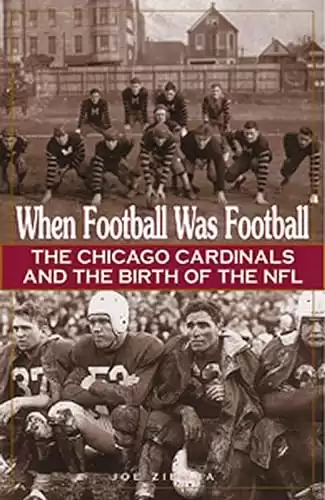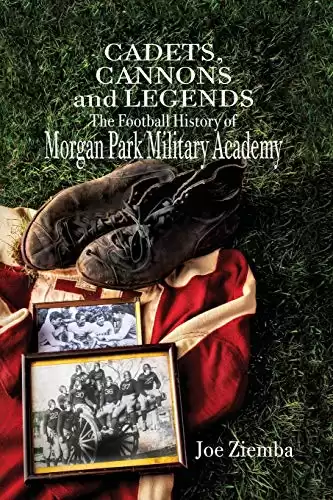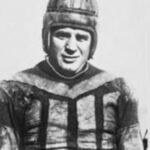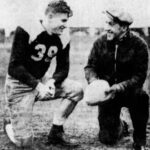Welcome to this episode of “When Football Was Football.” We hope that you enjoy our regular excursions back to the early days of football but don’t forget that the Sports History Network now includes over 20 podcasts related to sports history. We invite you to sample some of these excellent programs at your convenience!
Today, we’re going to cover a couple of scandals that rocked the early NFL, but then focus on how one individual overcame a big hit to his reputation due to a scandal to become one of the most famous athletes in the country. Along the way, he also served as one of the most effective, and elusive, spies for the United States during World War II!
Packers Kicked Out of the NFL!
But first, there’s a guy from Green Bay that is so beloved that the Packers’ stadium is named after him. You guessed it: Curly Lambeau.
Did you know that in his eagerness to make an impact on the NFL during the 1921 season, he ignored one of the cornerstone rules of the league and as a result, the Packers were booted out of the circuit in January of 1922? Here’s what happened…
In late 1921, Lambeau scheduled back-to-back games in Chicago against the Cardinals and the Bears. On November 20, the Packers tied the Cardinals 0-0, but a week later dropped a 20-0 decision to the Chicago Staleys (now the Chicago Bears).
The results of both games were impressive since the Packers, at the time, were having difficulty not only securing players but also in arranging for practice time.
The team relied on players from around the Midwest who usually gathered on weekends to practice before the game wherever the contest was scheduled. Lambeau pulled in as many players as necessary to fill out his game-day roster.
When the Packers played Racine on December 4, 1921, in Milwaukee, the Green Bay Press-Gazette reported that the battle would be for the “state professional football title,” and that “betting on the game is brisk.” Hank Gillo of Racine booted a 40-yard field goal in the fourth quarter to even the contest which ended in a 3-3 tie.
But in the post-game coverage, the Racine Journal Times reported that “Green Bay had several Notre Dame men from this year’s lineup with her. They were [Fred] Larson, at center, [Buck] Shaw, at left guard, and [Hunk] Anderson at left tackle. With the exception of the three Notre Dame stars, the lineups were the same as published [previously].”
Later, the Green Bay Press-Gazette noted that at the upcoming league meeting in Canton, Ohio on January 28, 1922, the “alleged violations of the eligibility rules concerning the use of college players, under assumed names by teams in the league, will be investigated by the board of directors. Chicago sportswriters have charged that the Green Bay Packers made use of Notre Dame players during the past season.”
Indeed, the Packers were ousted from the league at that meeting for using college players who still had eligibility remaining. But never fear Green Bay fans, the banishment did not last long. The Green Bay team that was kicked out in January of 1922 was owned by Emmet Claire of Chicago, said the Press-Gazette.
Later in 1922, a “new” Packers franchise, headed by Curly Lambeau himself, was admitted to the league. No one seemed to notice that the guy who brought in the college players to play in late 1921, was the same person bringing a “new” franchise to Green Bay in 1922!
Red Grange Signing: Shock and Profit!
The league was serious about not raiding college teams for talent and hoped to avoid any further negative publicity on the subject. This was all well and good until 1925 when Bears’ owner George Halas signed Red Grange of the University of Illinois to a contract as soon as Grange played his last game for Illinois in November of 1925.
In his autobiography, Halas admitted: “Even so, with our reworded ban on using collegians remained vague. An ingenious manager could find loopholes in it. I did so in 1925, to the profit of the Bears and, I believe, to professional football.”
The problem was that although Red Grange had completed his eligibility, he was still a college student whose class had not yet graduated. Halas interpreted the meaning of the rule to indicate that a player could be signed once his eligibility was complete, not when his class graduated.
This initiated another firestorm between the colleges and the dastardly pros, who apparently would stop at nothing in order to scoop up dollars at the expense of the baffled collegiate players. Not surprisingly, little effort was made to apologize for this transgression once it became apparent that Grange was not only a money-making machine for the pros, but also the one person likely responsible for pushing pro football, and the NFL, into the national limelight.
Marriage and Football Don't Mix
Our final scandal also involves the familiar characters of Curly Lambeau, Notre Dame, and George Halas and takes place in 1930. Notre Dame was on a roll in 1930, crushing opponents almost weekly en route to an undefeated 10-0 season and a second straight national championship.
Among the highlights was the closest game of the year, a 7-6 decision over Army before over 110,000 at Soldier Field in Chicago, followed a week later with a season-ending 27-0 blanking of Southern Cal in Los Angeles in front of 74,000 fans.
But this is where our “scandal” comes in. Midway through the season, it was rumored that Notre Dame All-American fullback Joe Savoldi was married, which was considered a strict infringement of the student rules at the Catholic university. Savoldi denied it, but he was soon dismissed from school for violating a university rule regarding secret marriages.
Apparently, once Savoldi was no longer a member of the Notre Dame football team, Curly Lambeau quickly signed him. But after receiving immediate criticism for this activity, especially from George Halas, Lambeau dropped the Savoldi agreement.
Bears Sign Savoldi
At this point, we’ll let George Halas of the Chicago Bears tell his side of the story. Halas wrote:
“Halfway through the 1930 season, Notre Dame expelled one of its more colorful players, Jumping Joe Savoldi, for offending a Notre Dame rule against marriage. The expulsion became a popular subject of discussion for the press, radio, and the public. I offered him a place on the Bears. He accepted quickly.
I was well aware of the very solid rule the League had made, with my help, against teams signing players before their class was graduated but I told myself, and anyone who asked, that Jumping Joe was a special case. I was not taking him out of school. Notre Dame had put him out. He was no longer a collegian, by action of the college officials.”
Immediately, Halas added Savoldi to the Bears lineup which was baffling after the criticism he leveled at Lambeau for doing the same thing. Joe participated in his first Bears practice on Monday, November 24, joining Red Grange and Bronko Nagurski in the backfield. When asked his opinion about the pros, Savoldi stated:
“It’s a lot different in some ways and no different in others. However, I can plainly see that I mixed in with a bunch of smart players. They know all of the tricks of the game and I’ve got the idea already that I’m in a tougher field.”
In his first game with the Bears, Savoldi scored the only touchdown of the day in a 6-0 win over the Cardinals. But Halas was about to be called before league president Joe Carr to discuss the signing of Savoldi.
Halas said: “Before long Mr. Carr told me I was guilty of offending the League rule. I put my case. He said the expulsion did not change the rules. The rule said a player could not be signed until his class was graduated. He agreed the rule did not allow for the possibility of expulsion and, because of that, he would not impose a fine although he would declare me guilty. I said in that case, he must fine me. He did. I had to pay $1,000. Perhaps Savoldi was worth it.”
Savoldi played the final three games of the season with the Bears but then left pro football to pursue a more lucrative endeavor: pro wrestling. He continued in the ring from 1932 through 1950, enjoying rich paychecks and fan adulation
From Football to Spy
Savoldi was actually born in Italy as Giuseppe Antonio Savoldi on March 5, 1908. Because of his linguistic skills–he was fluent in several Italian dialects—Savoldi was invited by the government in 1942 to become part of an espionage unit for the Office of Strategic Services (OSS).
Working undercover with the code name of “Sampson,” and going by the assumed name of Giuseppe DeLeo, Savoldi took part in special operations during the war in Italy, France, and North Africa. Because of his Italian background and language skills, Savoldi was able to infiltrate enemy resources and help remove valuable scientists, as well as disrupt black market activities. Savoldi also spoke Spanish, French, and a bit of German, making him a highly valuable resource for the allies.
His work was highly classified, extremely dangerous, and because of its secrecy, not well known at the time. A book called “Cloak and Dagger,” published after the war discussed some of his heroics. The book was later made into a movie starring Gary Cooper.
After the war, Savoldi continued to wrestle but was hindered by arthritis. He then became a teacher in Henderson, Kentucky. “Jumping Joe” Savoldi, an All-American on the football field and during the war, passed away at the age of 65 in 1974.
Scandals of a different type have surfaced in the NFL since the signing of the married Joe Savoldi caused such a stir in 1930. But at the time, the thought of a married football player at Notre Dame was sensational and Joe Savoldi paid the price by missing out on the final weeks of his college career. His signing by the Bears caused further friction but also helped the NFL tighten its regulations regarding the signing of eligible players.
Thank you, as always, for joining us, and we look forward to sharing another great story in our next episode of “When Football Was Football.” We’ll meet the man who scored the first NFL touchdown in Cardinals’ history but he is better known today as a member of the basketball hall of fame! Don’t miss this one!
Author and Host - Joe Ziemba
Joe Ziemba is the host of this show, and he is an author of early football history in the city of Chicago. Here, you can learn more about Joe and When Football Was Football, including all of the episodes of the podcast.
Please Note – As an Amazon Associate I earn from qualifying purchases
Resources
More From When Football Was Football
Paddy Driscoll’s Almost Perfect Season
Back at the beginning of the National Football League in...
Read More120,000 Fans Witness High School Football Game in 1937!!!
Let’s set the stage… It was a warm November afternoon...
Read MoreIn The Beginning: An Interview With Joseph T. Sternaman
And, you may ask, who is Joseph T. Sternaman? Sternaman...
Read More1948: The Last Hurrah of the Chicago Cardinals
Cardinals’ fans are familiar with the long, sad story concerning...
Read More




